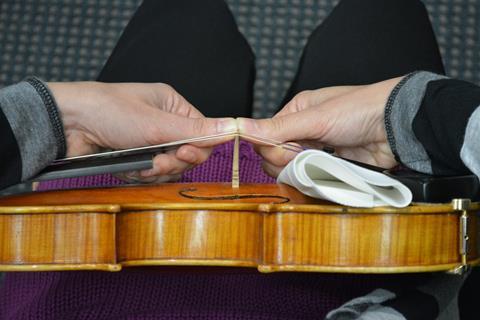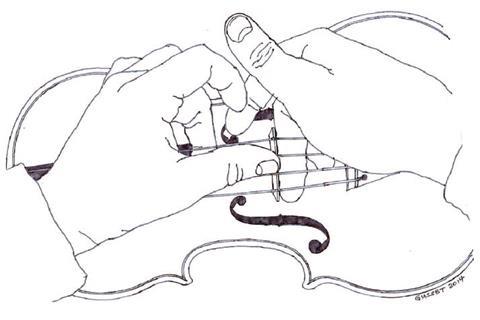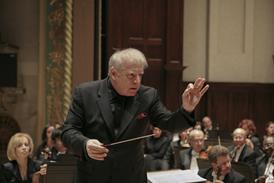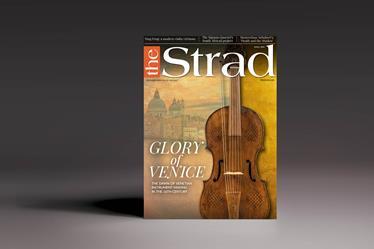Three top luthiers answers a reader's query on preserving the correct instrument geometry after changing strings, in this feature from 2014

The dilemma I always change my strings one at a time, usually playing one in for ten minutes or so before changing another. But sometimes I notice, after a lot of retuning during the settling period, that the angle of my bridge has changed. Is there any way I can prevent this from happening? And when it does happen, what's the safest way to push it back into the correct position? (Also, how can I tell that it is in exactly the right position?)
JERRY PASEWICZ
This is a common issue. When changing your strings, take a sharp pencil and put a little graphite into the string groove for lubrication, both at the bridge and at the nut. After each string-change, check the bridge for straightness by looking at it from the bass side – it is the treble (soundpost) side that is more likely to be distorted. Your bridge is straight if its back is almost at a right angle with the violin’s top on the tailpiece side, and the very top of the bridge is fading slightly towards the fingerboard. If this is not the case, your bridge can be corrected with the following steps:
Hold the violin in your lap with a polishing cloth under the tailpiece, the neck towards the left, and the bass side towards you. Place your right-hand fingers under the tailpiece, with your thumb touching the bridge between the A and D strings. Next, place your left-hand fingers under the fingerboard with your left thumb touching the bridge, opposite your right thumb, also between the A and D strings (figure 1, above).
With slight pressure from thumb to thumb, gently move the top of the bridge towards the tailpiece, keeping your right thumb in place as a brace. Using this technique should allow you to keep your bridge straight.
It can also be useful to measure the distance from the end of the fingerboard to the top of the bridge, so you can refer to it when adjusting the bridge in future. For greater accuracy you can ask your luthier to make a small reference stick for this measurement. It is possible to make a bridge that would never need to be straightened, but it would not be something you would want to have on your instrument.
Jerry Pasewicz is a luthier based in Raleigh, NC, and the current chair of the Violin Society of America’s International Violin and Bow Makers Competition
NICOLAS GILLES
When new strings are settling down, retuning them multiple times will always cause the bridge to move slightly in the direction of the fi ngerboard. It is a good idea to change one string at a time, as this will help prevent the soundpost from collapsing. In the first instance, the best advice would be to see a violin maker to ensure that everything is all right with the bridge, and to learn about the particular needs of your instrument.
To pull back the bridge, gently place the palms of your hands on to both of the violin’s lower corners, and grab the bridge between your thumb and index finger on both sides of the bridge. Then pull back the bridge in the direction of the tailpiece. The back of the bridge must be perpendicular to the arching.The bridge should be centred in line with the fingerboard. Put the top of the scroll on your cheek and look down the fingerboard to check that the bridge is in line with it. In practice, putting a bridge back in place is not too difficult but it requires some care. A luthier will be happy to show you how to treat your instrument with the care it deserves.
Nicolas Gilles is a luthier based in Montpellier, France
DAVID GUSSET
With a number of online businesses selling discounted strings, many players are content with receiving their strings by mail and changing their own. Unfortunately, in so doing, the need to visit the violin shop is also discounted, at the cost of a missed opportunity to have the health of their instruments routinely examined by an expert (not just a teacher).
A good shop will check the instrument for open edges and developing cracks, and offer the player guidance on the proper position and angle of the bridge while also inspecting the bridge for warping. I always check to see that the fingerboard is not coming loose from the neck or if it needs resurfacing. I lubricate string grooves with graphite, inspect the pegs for fit, and lubricate them with peg compound. Still, learning the proper method for changing strings and being familiar with the correct position and angle of the bridge and how to adjust it is useful knowledge for any string player.
The instrument’s bridge is held in place only by the tension of the strings, and when properly fitted, the soundpost is only barely snug between the front and back plates. How tightly the post fits between the top and back plates can also vary seasonally, because wood of the violin body changes its dimensions with fluctuations in relative humidity. Removing all the strings and bridge tension at the same time could cause a soundpost to topple over.

Leave the simultaneous removal of all four strings to the violin shop to preserve the set-up, by measuring the exact position of the soundpost and the bridge beforehand. For the player changing his or her own strings, it is best to remove and replace one string at a time, so as not to disturb the position of the soundpost or bridge. Changing strings can be done one after another without the individual string play-in.
I often start by installing and lightly tightening the new strings, but not immediately tuning them up to pitch, then checking the angle of the bridge and tightening the strings some more. You should be familiar with the proper angle of your bridge and frequently push the top of the bridge back as you continue to bring the strings up to pitch. Of course, the bridge should be checked for angle every time the strings are tuned in the future and especially in the first few days of stretching in new strings.
The correct angle of the bridge is achieved by having the back side of the bridge (the side facing the tailpiece) standing relatively perpendicular (90 degrees) to the table of the violin. This applies equally to a viola bridge and also to the lower portion of the back side of a cello bridge. A violin or viola bridge is finished flat on the back side and slightly chested or arched on the front side. A cello bridge is chested on the front side, but must also be finished with some curvature from the upper edge part way down on the back, particularly on the A string side. As a rule, the approximate perpendicular positioning of the back of the bridge gives the impression of the bridge leaning slightly back in relation to the belly, but allows the bridge wedge to exactly bisect the angle of the strings passing over the upper edge of the bridge.
After installation, most strings will continue to stretch to some degree, especially during vigorous performance. Since 6/7 of the vibrating string length of an instrument is located to the front side of the bridge and 1/7 of the string length is on the back side, it is only natural that when strings are tightened using the pegs most of the slack is taken up between the nut and the bridge thus pulling the upper edge of the bridge in the direction of the nut, causing it to lean or bend toward the fingerboard.
The feet of a properly cut bridge are fitted to match the contours of their locations on the belly. As the bridge begins to lean, the downward pressure of the strings will compel the feet to stay in flat contact with the belly, thus causing the bridge to bend, which when left unchecked will create extreme stress on the waist (middle) of the bridge and may eventually cause the bridge to warp or even break, requiring the costly bridge replacement. In the process of tuning the violin, the bridge must be frequently examined and adjusted for its proper angle.
The safest way to adjust the bridge without danger of pushing it over is performed in the following manner. Sit in a chair and place the instrument across your lap with the scroll to the left. The right index or middle finger should be extended under all four strings from the far side. The left hand is positioned comfortably around the strings to the front of the bridge with thumb at the center of the crest of the bridge between the centre two strings and the middle finger braced against the end of the fingerboard. With the right index or middle finger slightly lifting some of the tension of the strings off the bridge, the left thumb can gently push the upper edge of the bridge the required amount into the cushion of the right index finger. The finger doing the lifting will act as a stop so that the bridge cannot actually be pushed over or too far (see illustration).
David Gusset is a luthier based in Eugene, Oregon
First published in the The Strad's December 2014 issue
Best of 2023: The Strad’s Twelve Days of Lutherie
- 1
- 2
- 3
- 4
- 5
- 6
- 7
- 8
- 9
 Currently reading
Currently readingAsk the Experts: how to correct a violin bridge position
- 10
- 11
- 12
- 13














































No comments yet